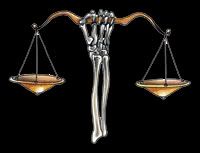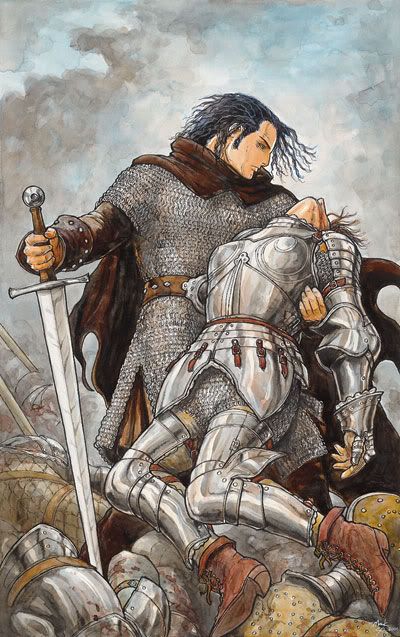Post by karajix101 on Feb 10, 2012 17:25:32 GMT -5


Lord of the Dead, Judge of the Damned, Lord of the Crystal Spire
Greater Deity
Symbol - Upright skeletal arm holding the golden scales of justice
Home plane - The Fugue Plane
Alignment - Lawful neutral
Portfolio - Death, The dead
Worshippers - The dying, families of the dying, grave diggers, hunters of the undead, morticians, and mourners
Cleric Alignments - LG, LN, LE
Domains - Death, Fate, Justice
Favoured Weapon - Bastard sword
Kelemvor (pronounced KELL-em-vor) Formerly Kelemvor Lyonsbane, also known as the Lord of the Dead and Judge of the Damned, is the god of death and the dead, and master of the Crystal Spire in the Fugue Plane. In his mortal days, Kelemvor was a skilled mercenary, with the heart of a noble paladin, concealed under rude manners and thwarted by his mysterious family curse.
Fair yet cold, Kelemvor is the god of death and the dead—the most recent deity to hold this position, following in the footsteps of Jergal, Myrkul, and Cyric. Unlike these other deities, whose rule as gods of the dead made the afterlife an uncertain and fearful thing, Kelemvor urges knowledge that death is a natural part of life and should not be feared as long as it is understood. is the latest in a long line of Faerûnian deities to command the forces of death and oversee the fate of the dead. Death has been the greatest constant throughout human history, but the way humans have viewed this unavoidable force has changed considerably as different deities arose to oversee it. During the reign of the inscrutable Jergal, death and the afterlife held a great deal of mystery for the common person. Most feared what they did not know or understand. When Myrkul took the office of Lord of the Dead after Jergal tired of it, humanity's worst fears were given form. Evil cultists reminded the living of the dead's power and influence, which extended far beyond the grave. In those days the lines between dead and undead became blurred, and commoners knew that to be taken by Myrkul's embrace was no protection from being raised by some demented necromancer. Things got worse when Myrkul was destroyed during the Time of Troubles and Cyric assumed the role, as the notoriously petty and flawed Black Sun seemed to offer not even the pale assurances of his forebears. Kelemvor, who assumed the mantle ten years after the Godswar, has taken a decidedly different approach. Kelemvor urges his clerics to act as stewards of the afterlife and to teach the people of Faerûn that death is a natural part of life. There is nothing to be feared in the transition, for only the truly wicked, the Faithless, or the False must fear the world beyond the Fugue Plane. Kelemvor views all undead as abominations, ordering his servants to destroy them at every turn. Kelemvor is a taciturn deity, and until recently was not completely sure of himself or his role. He has placed such uncertainties behind him, however, and approaches his duty as judge of the afterlife earnestly, tempering his strong sense of justice with kindness and forthrightness. He is not, however, particularly clever, and prefers to solve problems with direct action that sometimes leads to unintended results.
Kelemvor's clerics make every attempt to minister to the common people, to demystify the process of death and help the bereaved cope in times of loss. Most folk welcome the appearance of clerics of Kelemvor, thankful for their light touch and calming demeanors -- a welcome change from the days when unsettling clerics of Myrkul demanded funerary fees that seemed all too close to extortion. Children (particularly those growing up near evil kingdoms) hold militant clerics and paladins of Kelemvor in awe as undead hunters, and communities beset by the attentions of necromancers or tomb robbers often come to his clergy for aid.
Clerics of Kelemvor pray for spells at sundown. Most holy ceremonies involve blessing a soul for the transition into the afterlife. If present at the moment of death, a cleric of Kelemvor performs the Passing, a simple ritual altering Kelemvor to the arrival of this new wanderer on the Final Road. When an entire battlefield or plague-ravaged community requires last rites, Kelemvorite devotees perform the Lament for the Fallen. This ceremony, similar to the Passing, features low, droning chants, and rhythmic beating of ash staffs upon the open ground. At a private ceremony known as the Daeum, clerics of Kelemvor celebrate their deity's soothing doctrine and fund church activities with the goods of those who have died without heirs. Both Shieldmeet and the Feast of the Moon are of special spiritual significance to Kelemvor's adherents, when clerics recount the Deeds of the Dead that they never be forgotten. Rarely, powerful clerics use these days to cast true resurrection, returning to life heroes of the distant past who are needed in the present day. Kelemvor's clerics sometimes multiclass as necromancers, rangers, or doomguides using their knowledge to hunt down and destroy undead. Clerics of Kelemvor never rebuke or command undead.
Worshippers;
The death clergy as they are known have many duties, most involve tending to the last wishes of the dying and provide burial services to those who die alone. They also set out to cure diseases and defend people from monsters so that folk do not die before their time. Their final and debatably most important task is the destruction of undeath in all its various forms as it is an affront to Kelemvor. Elite priests of Kelemvor are known as Doomguides. Servants of Kelemvor are usually clad in somber gray vestments and brandish hand-and-a-half swords, or Bastard Sword.
There are two major centres of worship devoted to Kelemvor, the Tower of Skulls in Ormath and the huge monestary in Ormpetarr constructed in 1479 DR.
Orders;
Most Solemn Order of the Silent Shroud
An organization of gravediggers, embalmers, and other cemetary workers and crafters. Those of this order identify each other with a series of secret signs. Their task is to keep the church informed of undead sightings and gravesite desecrations.
Eternal Order
This recently established knightly order's purpose is to hunt and destroy powerful undead. They develop powerful undead-fighting powers by sacrificing other paladin abilities.
History & Relationships;
As mortals, Kelemvor and Midnight were lovers, but it is unlikely this was maintained after Midnight's ascension to take Mystra's place as they were afterwards both deities with responsibilities. Kelemvor's greatest enemy is Cyric, but he also fiercely opposed the machinations of Velsharoon, the necromancer god who animated the dead into undead and thus stood against everything Kelemvor works for, and Talona, for the unnatural deaths caused by her diseases. This also makes him an ally of Lathander the Morninglord, who also opposes undeath. Kelemvor maintains practical alliances with good and neutral-aligned gods of death in other pantheons — Sehanine Moonbow primarily and formerly Urogalan and Osiris as well. Kelemvor is served by the original deity of death, the mysterious, fatalistic, and pragmatic Jergal, who keeps records of the final disposition of spirits of the deceased.
Dogma;
Recognize that death is part of life. It is not an ending but a beginning, not a punishment but a necessity. Death is an orderly process without deceit, concealment, and randomness. Help others die with dignity at their appointed time and no sooner. Speak against those that would artificially prolong their life beyond natural limits, such as the undead. Do honor to the dead, for their strivings in life brought Faerûn to where it is now. Forgetting them is to forget where we are now, and why. Let no human in all Faerûn die a natural death without one of Kelemvor's clerics at her side.
Clergy & Temples;
Clerics of Kelemvor perform funerals, settle the affairs of the dead, and often are called upon by local lords or magistrates to oversee the execution of last wills and testaments. They preach to the masses the doctrine of a peaceful afterlife journey, and ensure that the bodies of the dead are buried safely and according to religious tradition. They mark sites ravaged by disease with plague warnings, and attempt to cure disease wherever they encounter it. Clerics of Kelemvor consider all undead abominations, and do whatever they can to put them to eternal rest. They contend that those who create undead are fit only for swift and utter destruction (an important difference between the Kelemvorite clergy and that of Jergal, who hold that certain undead have their uses). Kelemvorite clergy sometimes declare crusades against the undead or against creatures deemed to have caused too much untimely death. Occasionally, this leads them to employ adventurers to solve problems with which they cannot contend alone.
Members of the clergy tend to be taciturn, even morose at times. Many came to the church after losing loved ones to undead incursions, or even after dying themselves and being so profoundly touched by the experience that they enrolled in the clergy shortly after returning to life. Many of the older members of the clergy once worshiped Myrkul, and even fourteen years after that deity's destruction, some have difficulty coming to grips with the doctrinal differences between the two faiths.
Many of Kelemvor's temples used to be temples of Myrkul, and hence have less inviting or soothing architecture than their high clerics might prefer. Bone-and-Skull motif's predominate, and some of the larger temples even feature now-sealed chambers once used for revivification or darker rites.
Avatar;
Kelemvor's Avatars reflect the deities attachment to his original mortal form. Tanned and weathered from travel, these square-jawed avatars wander the Material Plane quietly, often venturing to the sites of recent battles to ensure that the spirits of the dead pass on as they should to the afterlife. Over the past three years, Kelemvor has become less interested in manifesting in Faerûn. Instead, he sends his avatars on recovery missions to rescue souls wrongfully condemned to the Lower Planes.

